|
< Earlier Kibitzing · PAGE 2 OF 2 ·
Later Kibitzing> |
| Feb-13-15 | | stst: The K has to be locked, and first striking with Rxh7 will release it. Have to give a pause-move to double up the R's first: 26. Rh1
IF (A) ........ KxP
27.R(2)xh7+ Kg8
28.Rh8+ Kg7
29.R(1)h7+ Kg6
30.NxN+ dxe5
31.Qxf7#
IF (B) ........ h6/h5
27.R(2)xP Qc6 (what else?)
28.Rh8+ KxP (as before)
29.R(1)xh7+ Kg6
30.NxN+ dxN
31.Qxf7# |
|
Feb-13-15
 | | al wazir: I would play 26. Rdh1. That wins in all the lines I looked at. |
|
| Feb-13-15 | | sorokahdeen: Seeing how attacks work is fascinating. |
|
| Feb-13-15 | | gofer: This looks like the usual rook sac on h7. If black accepts
we have a reloader to play, but first I would try to play
Qxf7 killing the game. So the order I would try for is...
(1 Rxh7 2 Bxe5 3 Qxf7)
<26 Rxh7+ ...>
Black cannot refuse the sacrifice...
26 ... Nxd3
27 Qf5! 
White's threat of Rh8+ Kxg7 Qh7# is unstoppable! So Nf5
cannot go anywhere!
The pawn threats are minimal...
26 ... b3
27 axb3 axb3
28 c3 
26 ... a3 can simply be ignored
The rook threats are also muted as
26 ... Rbc8/Rdc8
27 Rdh1 Qxc2+
28 Ka1 ...
Black doesn't have enough mating material! Bf4, Nd3 and Rh1
are all protecting c1 and so any attempt on mate will be too
slow...
28 ... a3
29 Rh8+ Kxg7
30 Bxe5+ Kg6 (dxe5 31 R1h7+ Kg6 32 Qxf7+ Kxg5 33 Rg7#)
31 Rah6+ Kxg5
32 Bf6++ Kg4
33 Qf5+ Kg3
34 Rh3+ mating
So all black might try to do is trade off queens...
26 ... Qc6 loses the queen!
27 Bxe5 
26 ... Qb7
27 Bxe5 dxe5
28 Qxe5! ...
28 ... Kxh7+ 29 Rh1+ Kg8 (Kg6 R1h6#) 30 Rh8#
28 ... Bf6 29 Rh8+ Kxg7 30 Qxf6#
<26 ... Kxh7>
<27 Bxe5 ...>
Black cannot take back the piece...
27 ... dxe5
28 Qxf7 ...
White threatens g8=Q# and Rh1# So black must find an
alternative
<27 ... Bxg5>
<28 Rh1+ Kg6>
<29 Nf4+ Bxf4>
<30 Bxf4 ...>
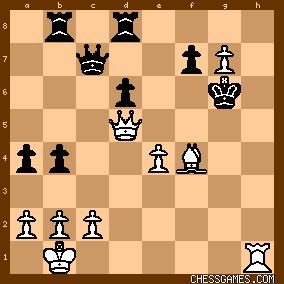
click for larger viewBlack's defences are floundering...
30 ... Qd8/Qc8
31 Qg5#
30 ... Kxg7
31 Qg5+ Kf8
32 Rh8#
30 ... f6
31 Rg1+! Kh7
32 g8=Q+ Rxg8
33 Qh5#
<30 ... Qe7>
<31 Rg1+ ...>
31 ... Kh7
32 g8=Q+ Rxg8
33 Qh5#
<31 ... Qg5>
<32 Qxg5+ Kh7>
<33 g8=Q+ Rxg8>
<34 Qh6#/Qh5#/Qh4#/Rh1#> ~~~
Ditto <Phoney>. A classic simple recognisable combination. I missed the rook push to h8+ followed by its sacrifice on h7 having
cleared the g7 pawn - <very nice> - and I will have to keep that in my memory for another day, when I might get the chance to repeat it!!! But still I didn't think black had any chance of either rook move coming to anything as c1 is so well guarded!!! |
|
| Feb-13-15 | | pedro99: Rdh1 is too slow.Black plays ..b3 and penetrates first. |
|
| Feb-13-15 | | morfishine: Pattern recognition: White strives to penetrate his Queen to <f7> allowing mate on the h-file. This requires trading a rook for pawn at <h7> 26.Rxh7 Kxh7 (or 26...Nxd3 27.Qf5 Nxf4 28.Qxf4 Kxh7 29.Qxf7 Rf8 30.Rh1#) 27.Bxe5 dxe5 28.Qxf7 Rd6 29.Rh1+ Rh6 30.Rxh6# Its important to eliminate other moves/move-orders which fail in the long-run ***** |
|
Feb-13-15
 | | offramp: The best part is that white realised that he had to give up that evil-looking pawn on g7. It was in the way! |
|
| Feb-13-15 | | JimNorCal: The final move 29. Rh7+ is lovely. |
|
| Feb-13-15 | | zb2cr: Found this one. No time to comment further. |
|
Feb-13-15
 | | Penguincw: I got some of those moves in some order: 26.Rxh7 Kxh7 27.Bxe5 dxe5 28.Qxf7. However, 26...Kxh7 is not best. Still, is it me or have the puzzles been fairly easy this week? |
|
| Feb-13-15 | | patzer2: Picked 26. Rxh7!! as my solution to today's Friday puzzle. However, other than the general idea 26. Rxh7 Kxh7 27.Bxe5 dxe5 28.Qxf7, I missed a lot of the more difficult possibilities. Here's my look with Fritz 12:
<26. Rxh7!! Rdc8>
If 26... Kxh7, then 27. Bxe5 Bxg5
(27... Kg8 28. Bf6 Bxf6 29. gxf6 Rb5 30. Rh1 Qxc2+ 31. Kxc2 Rc8+ 32.
Kb1 Rc1+ 33. Nxc1 Rxd5 34. Rh8#;
27... dxe5 28. Qxf7 Bxg5 29. g8=Q+ Kh6 30. Qgh7#) 28. Rh1+ Bh6 29. Bf4 Rb5 30. Qxb5 Kg8 31. Rxh6 f6 32. Qd5+ Qf7 33. Rh8+ Kxg7 34. Rh7+ Kxh7 35. Qxf7+ Kh8 36. Be3 b3 37. Bd4 bxa2+ 38. Kxa2 Rg8 39. Bxf6+ Rg7 40. Qxg7#. <27. Rh8+ Kxg7 28. Bxe5+ dxe5 29. Rh7+ 1-0> Black resigns in lieu of 29...Kg6 (29... Kxh7 30. Qxf7+ Kh8 31. Rh1#; 29... Kf8 30. Qxf7#) 30. Qxf7+ Kxg5 31. Rg1#. P.S.: Black's last chance to hold appears to be with the missed opportunity 22...Qb7!, when Fritz 12 indicates strong could go 22... Qb7! 23. h6 Qxd5 24. exd5 Rg8 25. Re1 f6!  to to  . . |
|
| Feb-13-15 | | Cheapo by the Dozen: I haven't seen anything better than the quiet 26 Rdh1. Its two immediate virtues are: A. White threatens mate.
B. By breaking the d-file Q-R skewer, White threatens Nxe5 winning a second pawn. Black looks fairly OK after
26 Rdh1 Nxd3
27 cxd3 Rdc8
So I imagine I'm overlooking a way to make one of the flashy kingside sacrifices work. |
|
Feb-13-15
 | | Jimfromprovidence: I went with 26 g6!?
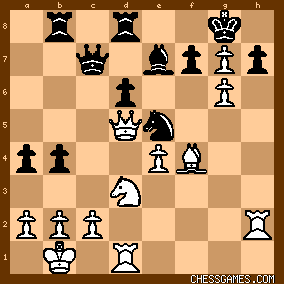
click for larger view The main threat is 27 Nxe5, seeing 28 Qxf7#.
If 26...Nxg6, then 27 Qh5 threatening 28 Qxh7#.
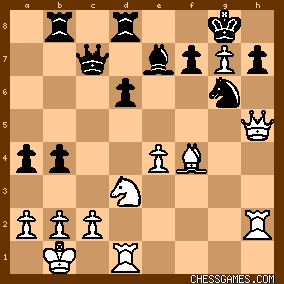
click for larger viewIf 26...Bf6, then 27 Rg1 threatening 28 gxh7#.
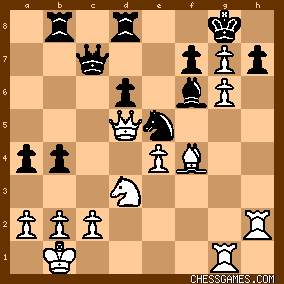
click for larger viewBlack has a lot to think about. |
|
| Feb-13-15 | | TheaN: Friday 13 February 2015 <26.?> Friday the 13th. Not superstitious per se, but this Friday puzzle is tough. I guess that the initiation move is clear to most, but the continuation is what is hard. White starts the breakthrough on the black kingside with <26.Rxh7!>. White can do this because of the potential reload on h1, the pawn on g7 and part control of f7. In these kind of unbalanced Sicilian positions declining a sac is usually the best; continue with your own attack. In this case, I analyse black accepting the sac first: A) <26....Kxh7 27.Bxe5!> reloading on h1 immediately is worse, because g7 is undefended. After Bxe5, white defends g7 and threatens Qxf7 or Rh1+. To illustrate, after 27.Rh1+? Kg8 28.Bxe5 dxe5 29.Rh8+ Kxg7 30.Rh7+ Kxh7 31.Qxf7+ Kh8 32.g6 Bf8! 33.Qxc7 Bg7  and I think white missed something. and I think white missed something. A1) <27....dxe5? 28.Qxf7  > and mate will follow soon: 28....Rg8 is the only move defending against g8=Q++ and disaster, but that allows 29.Rh1#. > and mate will follow soon: 28....Rg8 is the only move defending against g8=Q++ and disaster, but that allows 29.Rh1#. A2) Counterattacking comes too late for black: <27....b3? 28.Rh1+ Kg6 (Kg8 29.Rh8#) 29.Rh6+ Kxg5 30.Bf4++ Kg4 31.Qh5#>. Retreating the king is an interesting defense, as it defends f7 and voids white's tempo gain with Rh1+: after Rh1, black can capture on e5: A3) <27....Kg6> exposes the king too much <28.Nf4+ Kxg5 (Kh7 29.Rh1+ Kg8 30.Rh8#) 29.Rg1+ Kh6 (Kh4 30.Bf6+! Bxf6 31.Qh5#) 30.g8=N+! Rxg8 (Kh7 31.Qxf7#) 31.Bg7+ with 32.Qh5#>. A4) <27....Kg8> is more sturdy. I was intending to play <28.g6> to apply more pressure at f7, but I do think black can hold with <28....Bh4!>. A5) Even better is freeing up the bishop right away with <27....Bxg5!> after which <28.Rh1+> allows both Bh6 and Kg6, and I don't see the finish. Gonna stop, have been looking for an hour+, and can't find the complete combination. |
|
| Feb-13-15 | | TheaN: Typical, I saw the second rook sacrifice as well, but I couldn't find a winning combination after 27.Bxe5 Bxg5 28.Rh1+ Bh6!? Also, is there anything definite against 27.Bxe5 Kg8? Will look into this one more, it's interesting. |
|
| Feb-13-15 | | agb2002: White is one pawn ahead.
The obvious idea is 26.Rxh7, threatening 27.Rdh1 and 26.Rh8+ Kxg7 27.Nxe5 dxe5 (27... Kxh8 28.Qxf7 + -) 28.Bxe5+: A) 26... Kxh7 27.Bxe5
A.1) 27... dxe5 28.Qxf7 wins due to the double threat 29.g8=Q# and 29.Rh1#. A.2) 27... Bxg5 28.Rh1+
A.2.a) 28... Kg8 29.Rh8#.
A.2.b) 28... Kg6 29.g8=Q+ Rxg8 30.Bxd6 Qc8 (30... Qd7 31.Ne5+ and 32.Nxd7 + -; 30... Rb5 31.Qxb5 Qxd6 32.Qf5+ Kg7 33.Rh7+ Kf8 34.Qxf7#) 31.Bxb8 + - [N+P] (31... Qxb8 32.Qf5+ Kg7 33.Rh7+ Kf8 34.Qxf7#). A.2.c) 28... Bh6 29.Bf4 wins material with a crushing attack. A.3) 27... b3 28.Rh1+ Kg6 (28... Kg8 29.Rh1#) 29.Rh6+ Kxg5 30.Bf4+ Kg4 31.Qf5+ Kf3 32.Rh3+ and mate in two. B) 26... Bxg5 27.Rh8+ Kxg7 28.Rxd8 Rxd8 29.Bxg5 + - [B]. C) 26... Ng6 27.Rdh1
C.1) 27... Nxf4 28.Rh8+ Kxg7 29.R1h7+ Kg6 30.Nxf4#.
C.2) 27... b3 28.Rh8+ Kxg7 (28... Nxh8 29.gxh8=Q#) 29.R1h7#. D) 26... Nxd3 27.Rh8+ Kxg7 28.Rh7+ Kxh7 (28... Kg6(8) 29.Qxf7#) 29.Qxf7+ Kh8 30.Rh8#. E) 26... b3 27.cxb3 axb3 28.axb3, prevents the intermediate ... Qc2+ and Black has only lost another pawn without stopping the pending threats. |
|
| Feb-13-15 | | BOSTER: When black rooks were dancing from a8-c8-b8, and another from h8-f8-d8-c8, this doesn't look like the Tango without mistake. |
|
| Feb-13-15 | | Longview: I explored several candidate moves (26. Next, Bxe5, Rxh7, Rh1) and settled on g6 as the best treat. My second choice was Rxh7. The exchanges and tricks in the middle threatening both queens must wait. 26. g6 forces Black to choose between hxg6 and Nxg6 I believe. Nxg6 gives opportunity for Q-h5 threatening Qh7+. None of the Black pieces can come to the rescue. If hxg6 then Rd-h1 giving the h file attack that cannot be stopped, I believe. It appears to be like the Rxh7 pattern but no second pawn there. Also possible to keep an attack was 26.Rxh7 Kxh7 27.Rh1+ Kxg7 28. Bxe5+ dxe5 29. Rh7+ Kxh7 30. Qxf7+ with good chances using the pawn. I cannot see further than that in my head. |
|
| Feb-13-15 | | Longview: Well I did not see the 26. ... R-c6 response to Rxh7. It made it easier for White. |
|
| Feb-13-15 | | TheaN: <TheaN: Typical, I saw the second rook sacrifice as well, but I couldn't find a winning combination after 27.Bxe5 Bxg5 28.Rh1+ Bh6!? Also, is there anything definite against 27.Bxe5 Kg8? Will look into this one more, it's interesting.> Overestimation of the black resources, is the reason why I couldn't properly finish after 27.Bxe5 Kg8 or 27.Bxe5 Bxg5. In both cases, eliminating the only piece defending the black king, the bishop, is horror for black: respectively 27.Bxe5 Kg8 28.Bf6! Δ Rh1-h8, which persists after 28....Bxf6 29.gxf6, and 27.Bxe5 Bxg5 28.Rh1+ Bh6 29.Bf6! with the same idea, now Δ Rxh6+ with Qg5+. |
|
| Feb-13-15 | | Whitehat1963: I still don't understand why the black king can't take the rook on h7. I wouldn't have been able to find this in a hundred years. |
|
| Feb-13-15 | | patzer2: As others note here, there's more than one solution to this Friday puzzle. Fritz 12 indicates 26. Rh7! is strongest, but verifies other winning moves: Mircea-Emilian Parligras - Manuel Pereira Figueroa, Seville op 30th 2005
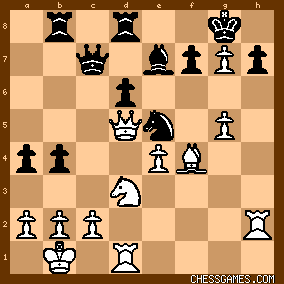
click for larger viewAnalysis by Fritz 12 @ 21/50 depth:
1.  (16.21): 26.Rxh7 Bxg5 27.Rhh1 b3 28.cxb3 Bh4 29.Rxh4 Ng6 30.Qh5 Kxg7 31.Bh6+ Kg8 32.Rg1 Rb7 33.Rxg6+ (16.21): 26.Rxh7 Bxg5 27.Rhh1 b3 28.cxb3 Bh4 29.Rxh4 Ng6 30.Qh5 Kxg7 31.Bh6+ Kg8 32.Rg1 Rb7 33.Rxg6+ 2.  (6.33): 26.g6 Bf6 27.Rg1 hxg6 28.Nxe5 dxe5 29.Rxg6 Bxg7 30.Rxg7+ Kxg7 31.Bxe5+ Kf8 32.Bxc7 Rxd5 33.exd5 Rb5 34.d6 Rf5 (6.33): 26.g6 Bf6 27.Rg1 hxg6 28.Nxe5 dxe5 29.Rxg6 Bxg7 30.Rxg7+ Kxg7 31.Bxe5+ Kf8 32.Bxc7 Rxd5 33.exd5 Rb5 34.d6 Rf5 3.  (3.94): 26.Rdh1 Qc4 27.Qxc4 Nxc4 28.Rxh7 b3 29.cxb3 axb3 30.a3 Rdc8 31.Bc1 Ne5 32.Nf4 Bxg5 33.Rh8+ Kxg7 34.R1h7+ Kf6 35.Nh5+ (3.94): 26.Rdh1 Qc4 27.Qxc4 Nxc4 28.Rxh7 b3 29.cxb3 axb3 30.a3 Rdc8 31.Bc1 Ne5 32.Nf4 Bxg5 33.Rh8+ Kxg7 34.R1h7+ Kf6 35.Nh5+ 4.  (3.92): 26.Rg1 Qb6 27.Rgh1 Qb5 28.Qd4 b3 29.Rxh7 bxc2+ 30.Ka1 c1Q+ 31.Nxc1 f6 32.g6 Nxg6 33.Be3 a3 34.b3 Ne5 (3.92): 26.Rg1 Qb6 27.Rgh1 Qb5 28.Qd4 b3 29.Rxh7 bxc2+ 30.Ka1 c1Q+ 31.Nxc1 f6 32.g6 Nxg6 33.Be3 a3 34.b3 Ne5 |
|
| Feb-13-15 | | CHESSTTCAMPS: White is up a doubled pawn, with a rook on an open h-file and a strongly posted queen on d5 exerting strong pressure on black's castled position. Black appears to be developing counterplay on the queenside, but may be intending 26... Qc4 to swap queens and relieve the pressure. I had one candidate that I liked immediately, and it works. 26.Rxh7!!
It's not too hard to see that the rook can't be taken, but it took me longer to see what the actual threat is. A) 26... Kxh7 27.Bxe5! dxe5 28.Qxf7 Rg8 (otherwise 29.g8=Q#) 29.Rh1# A.1) 27... Kg8 28.Bf6! and the threat of Rh1 followed by Rh8# is unstoppable, e.g. 28... Bxf6 29.gxf6 R(either)c8 30.Rh1 Qxc2+ 31.Ka1 Qc1+ 32.Nxc1 wins A.1.1) 28... Bf8 29.gxf8=Q+ Kxf8 (Rxf8 30.Rh1 forces mate faster) 30.Rh1 Ke8 31.Ne5! dxe5 32.Rh8# B) 26... Nxd3 27.Rh8+ Kxg7 28.Rh7+! (the trick that eluded me for a while) Kxh7 (otherwise 29.Qxf7+) 29.Qxf7+ Kh8 30.Rh1# C) 26... Bxg5 27.Bxg5 Kxh7 28.Bxd8 R|Qxd8 29.Nxd5 wins a piece D) 26... Bf8 27.gxf8=Q+ Rxf8 28.g6 wins.
E) 26... Bf6 27.gxf6 Kxh7 28.Rh1+ Kg6 (Kg8 29.Rh8#) 29.Rh6# Time for review.... |
|
| Feb-13-15 | | CHESSTTCAMPS: Missed the game defense, but had the key ideas in the other lines. |
|
| Feb-13-15 | | TheBish: M Parligras vs M Pereira Figueroa, 2005 White to play (26.?) "Difficult"
One thing that helped me solve this was noticing that if the knights were removed, Rxh7! would win, as after Black plays ...Kxh7, Qxf7 would threaten mate by both Rh1 and g8=Q. But taking the knight first would place White's queen under attack after 26...dxe5, taking away the possibility of 27. Rxh7. What if we change the move order? 26. Rxh7! Kxh7
If Black declines the rook offer, White will have a winning attack by doubling rooks followed by a timely Rh8+ followed by R1h7+. 27. Bxe5!
Keeps the g-pawn defended until White's next move.
27...dxe5 28. Qxf7 and there is no defense against 29. Rh1+ or 29. g8=Q+. There is probably much more to this, but short of time now. |
|
 |
|
< Earlier Kibitzing · PAGE 2 OF 2 ·
Later Kibitzing> |





